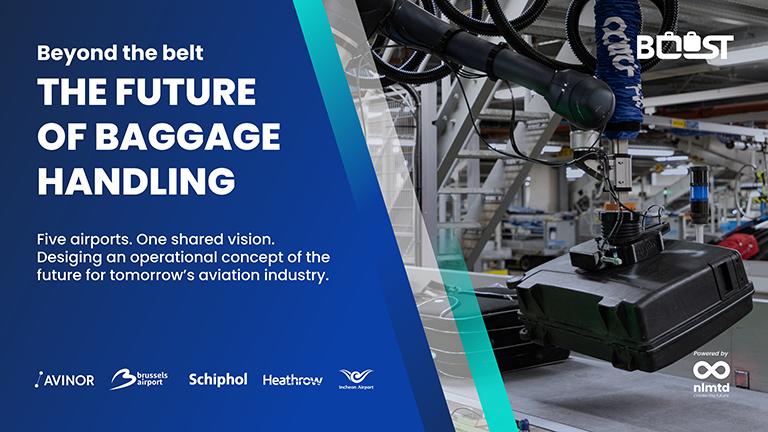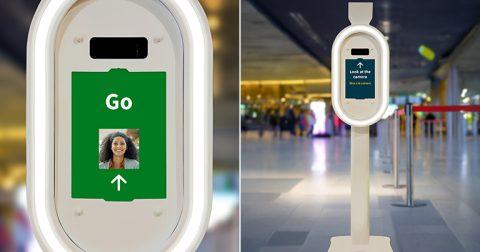Heathrow recently joined the pioneering BOOST initiative, alongside Amsterdam Airport Schiphol, Avinor, Brussels Airport, and Incheon International Airport. BOOST was launched by Future Travel Experience (FTE) and innovation consultancy nlmtd (Unlimited) and spun out of the FTE Baggage Innovation Working Group. It is focused on the rapid adoption of advanced technologies in the baggage journey, with the aim to eliminate physical strain and improve working conditions for baggage workers. In this video interview, following his participation at the recent co-located APEX FTE EMEA and Ancillary & Retailing events, Andy Miller, Head of Baggage, discusses Heathrow’s current baggage Proof of Concept, the newly launched BOOST White Paper that introduces a collective vision to transform baggage handling, and much more. Read our full report on the launch of the BOOST White Paper here.
For Heathrow, joining BOOST is about collaboration and shared innovation. As a member, the airport will work closely with other airports and industry partners to address the complex issues in baggage operations. According to Miller, the key to BOOST lies in the collective effort of airports who understand the scale of the challenges they face and are committed to finding practical solutions together. “It’s about like-minded airports who understand the problems we face in baggage. We’re collectively trying to work out how to solve these problems, and it’s about sharing information – not just among the airports involved, but across the wider industry. This collaboration helps drive baggage innovation and ensures that we are advancing toward solutions that work for the entire supply chain.”
Proof of Concept: bag alignment technology
As part of its commitment to innovation, Heathrow is actively working on a range of Proof of Concept (PoC) initiatives. One particularly exciting project involves a collaboration with Vanderlande – a Strategic Partner of Heathrow, as well as a Partner of the FTE Baggage Innovation Working Group – to improve bag alignment as part of the baggage handling process.
This initiative focuses on the alignment of bags as they move through the airport’s systems, particularly in screening areas. With robotics playing an increasingly important role in baggage handling, ensuring smooth bag alignment is crucial for system efficiency.
“The technology we’re prototyping with Vanderlande will be game-changing,” Miller explains. “It will significantly improve how our systems handle baggage, making the process faster and more efficient, while ensuring the bags are accurately aligned for further processing.”
Heathrow is also set to undergo a major upgrade to its baggage systems. The airport is replacing the outdated baggage handling system at Terminal 2, which currently operates within the old Terminal 1 building, with a new, state-of-the-art system. This upgrade brings an exciting opportunity for increased capacity, enhanced capabilities, and greater automation.
“Replacing the baggage system at Terminal 2 is a major step forward for Heathrow,” says Miller. “With the new system, we’ll be able to introduce more semi-automated processes, improving how baggage is handled and reducing the reliance on manual labour. This is a significant shift in the way we operate, and it will be implemented over the next few years.”
In addition to the system upgrade, Heathrow is exploring ways to enhance its existing robot-based baggage operations, further integrating automation into the baggage handling process.
Heathrow’s role in the new BOOST White Paper

Heathrow’s involvement in the BOOST initiative has also extended to the development of the newly launched BOOST White Paper, which outlines the future of baggage innovation. After joining BOOST, Heathrow has contributed to the collaborative efforts of the five airports involved in the initiative. The White Paper offers a roadmap for transforming baggage handling through technology, automation, and industry-wide collaboration. It is publicly available for anyone interested in exploring the future of baggage operations.
“It’s fantastic to see the White Paper launched,” says Miller. “It’s a result of the hard work of the five airports and is a valuable resource for anyone in the industry. Our goal is to help drive progress and innovation in baggage handling, and this paper is a step in that direction.”
The importance of collaboration: Heathrow’s role in the FTE Baggage Innovation Working Group
Heathrow’s participation in the FTE Baggage Innovation Working Group (BIWG) is another key aspect of its commitment to collaborating with innovators across the industry. The BIWG serves as a forum for airports, airlines, and technology providers to come together and discuss common challenges in baggage handling.
“The BIWG is crucial for collaboration and idea-sharing,” Miller adds. “We recently visited an Amazon site here in Dublin, where we had a chance to meet with other innovators in the industry. It was fascinating to realise that many of the challenges we face at Heathrow are shared by other airports. Bringing everyone together allows us to brainstorm solutions and work collectively to solve common problems.”
Read the full APEX FTE EMEA and Ancillary & Retailing 2025 report >> Learn more about the FTE Baggage Innovation Working Group >> Learn more about BOOST and the FTE Accelerating Collaboration & Engagement platform >>What’s next – FTE Global, LA, 9 to 11 September 2025, and APEX FTE Asia Expo, Singapore, 11 to 12 November 2025
Join us at FTE Global – the “CES of Aviation” – in LA, 9 to 11 September 2025 – registration live >> Join us at APEX FTE Asia Expo in Singapore, 11 to 12 November 2025 – registration live >>You may also be interested in
12 technology and CX trends that can enhance airline and airport operations in 2025
APEX FTE EMEA and Ancillary & Retailing 2025 in pictures – ‘Innovate to Elevate’








